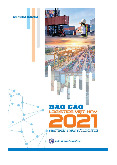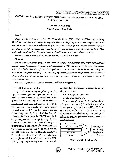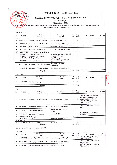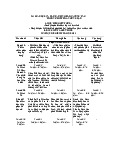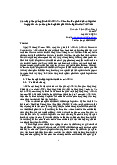



















Preview text:
ZARA Supply Chain Management Mona Singh 14868329 AUT UNIVERSITY | MEPM 2015
ZARA Supply Chain Management Table of Contents
1. Introduction....................................................................................................2
2. Supply Chain Model........................................................................................3
2.1 Design and order administration................................................................4-6
2.2 Sourcing and Manufacturing.....................................................................6-9
2.2.1 Suppliers of Zara............................................................................9-11
2.3 Distribution................................................................................................11-13
2.4 Retailing.....................................................................................................14
2.5 Merchandising............................................................................................15
2.6 Store Operations.........................................................................................15
2.7 Contracts......................................................................................................15-16
3. Cultural Aspects.................................................................................................17
3.1 Cultural comparison between countries.......................................................18-20
3.2 Cultural challenges.......................................................................................21
3.3 Key policies for senior management and leadership....................................22
4. Unethical Risk Management in Supply Chain...................................................23
4.1 Supply Chain ethics......................................................................................23
4.2 Unethical activities in supply chain management.........................................23
4.3 Tools for unethical risk management in supply chain...................................24-26
5. References............................................................................................................27
Mona Singh (14868329) MEPM 2015 1
ZARA Supply Chain Management 1. Introduction
Supply chain is defined as the global network used to deliver products and services from raw
materials to end customers through an engineered flow of information, physical distribution
and cash. Supply Chain Management encompasses the planning and management of all the
activities involved in designing, sourcing and manufacturing, distribution, retailing and
logistics. It also includes coordination and collaboration with channel partners which can be
suppliers, intermediaries, third party service providers and customers (Ayers).
Zara is a Spanish clothing brand based in Arteixo, Glacia owned by a Spanish tycoon
Amancio Ortego Gaona. Zara is a flagship chain store of Inditex Group which is the world’s
largest apparel retailer. The business model of ZARA is characterized be a high degree of
vertical integration as compared to models developed by international competitors. The
vertical integrated business model include all the phases of fashion process: Design,
manufacture, logistics, distribution to its owned stores. The key to this model is ability to
deliver products to customer as per their desire in shortest span of time. Time is the main
factor that is been considered as compare to the production cost in ZARA. Vertical
integration shortens the turnaround times and achieves greater flexibility thereby reducing the
stock inventory to minimum and hence reducing the fashion risk to greatest possible extent.
The best feature of ZARA supply chain management is that it takes maximum five to six
weeks to deliver the product to the customers as compare to its competitors which deliver the
final product in five to six months (Garcia).
The total brand value of ZARA is $9.4 billion as of May 2015 and the revenue generated is around $14.8 billion.
Mona Singh (14868329) MEPM 2015 2
ZARA Supply Chain Management
2. Supply chain Model
Zara has 2000 stores strategically located in 88 countries around the world. It becomes
challenging for such a firm to supply the orders as per the latest demand. Although Zara uses
its flexible business model in order to adapt to new changes as per the season and thereby
delivering the best output to the consumers as per their desires. Specific retail locations are
selected after an extensive market research to ensure that the target market segments by
ZARA is of sufficient size in that particular locality to render the store financially viable.
Moreover ZARA always tries to locate its stores in most up market with high traffic and
prestigious locations. These prime locations gives the opportunities to the customers to
browse the stores as and when they are going back from work.
The supply chain management of ZARA is divided into four categories as shown below:- Information Flow Design and order Administration Sourcing & Manufacturing Distribution Retailing
Mona Singh (14868329) MEPM 2015 3
ZARA Supply Chain Management
Zara vertical supply chain
2.1 Design and Order Administration
Zara designs all its products. It has a “commercial team” which consists of designers, market
specialists, and buyers. All of them are involved in detailed designing of the products where
the designers are the key players. Almost 40,000 products are designed every year out of
which 10,000 are selected for production.
The teams work on both next season’s design and simultaneously updating the current
season’s design in order to maintain a competitive edge. There is dynamic atmosphere among
the designers and design inspiration is from global sources which includes catwalk,
magazines, trade fairs, discotheques etc. Zara creates two basic collection each year- one in
fall/winter, other in spring/summer season. The designers take around nine months before the
start of season to make initial sketches. After the sketches are done, the sketches are redrawn
using Computer Aided Design (CAD) and further adjustments are done in order to find the
better matching of weaves, textures and colours. Later, the fabric and other components are
finalised by the designers. Simultaneously the price of the product is determined at which it
will be sold in future. The samples are presented in front of sourcing and product
Mona Singh (14868329) MEPM 2015 4
ZARA Supply Chain Management
development unit for selection process. The sourcing unit identifies the production
requirement and decides whether the item will be insourced and outsourced.
Based on this, the sourcing unit allocates a timeline to ensure that initial collection arrives
before the start of selling season.
The process of adapting to the changing trends and differences across market is more
revolutionary in order to find the demand of customers. The demand of target customers who
are very young and fashion conscious city dwellers plays an important role. Thus frequent
conversations with store managers becomes important to capture the sales data in IT system.
Various other sources of information includes TV, internet, university campus, film industry,
and even Zara’s fashion conscious staff. Market specialist plays an important role in linking
the designers and stores. Several dozens of items are designed each day but only one third of
the items goes into production. Due to time constraint, very limited volumes of items are
prepared and presented in key stores to determine customer response. If the customer
response is unambiguously positive then those items are produced on large scale.
Market specialist are in constant contact with the store managers through phones discussing
the sales order, new lines and other matters. The store managers are equally in contact with
Market specialist and thereby rely heavily on these discussions before placing the final order.
Thus the failure rate is supposed to be 1% compared with an average of 10% in this sector.
Overall, the responsibility of the design team is to track customer preferences and use sales
information along with other factors for a detailed analysis of product life cycle. Based on
this analysis the orders are repeated and new designs are given to internal and external
suppliers. Thereby the design teams with market specialists bridge the merchandising and
back end production process (Kasra Ferdows).
Mona Singh (14868329) MEPM 2015 5
ZARA Supply Chain Management
2.2 Sourcing and Manufacturing
Zara manufacture approximately 50% of its product in its own store in Spain but uses
external suppliers for all its sewing operations. Zara sources fabrics, threads and other
components from external supplier with help of purchasing offices in Barcelona, Hong Kong
along with sourcing personal in headquarters located at Arteixo, Spain. About one half of the
purchased fabric is not dyed in order to provide latest season fashion with maximum
flexibility, thereby reducing the waste cost. Comditel, a 100% owned subsidiary of Inditex
deals with number of external suppliers of fabric and other components. Comditel deals with
dyeing, patterning and finishing undyed fabric.
Due to the vertical integration of Zara, it makes around 40% of its own fabric and purses rest
of the dyes from its own subsidiary. After cutting and dyeing, the items are stitched with help
of many local cooperatives. Since Zara manufactures around 60% of its own product, hence it
is more flexible in variety, amount and frequency of new style that are produced. Fifty
percent of the items that are sold by Zara are being manufactured in Spain, 28 % in Europe,
and 24% in Asia and rest of the world. Zara has a global distribution centre that functions as mentioned below:
There is more risk involved in most fashionable item hence these type of items are produced
on small scale and if the customer response is positive then these items are reordered
depending upon the demand. The items that are price sensitive rather than time sensitive are
been outsources to Asia as the manufacturing cost in Europe is 15-20% higher as compare to
Asia. Zara has the ability to create rapid product turnover due to limited stock production and
controlled inventory. This creates opportunities in retail stores of Zara.
The quick response system of Zara is unique which consists of human resources and
Information technology. Zara focuses on ultimate customers and emphasizes on the use of
quick backward vertical integration rather than manufacturing efficiencies. It becomes crucial
for Zara to speed up the information flow from consumer desires to apparel designers. The
combination of vertical integration, technology-orchestrated coordination of suppliers, fined
tuned logistics and just in time manufacturing makes Zara so much competitive.
Mona Singh (14868329) MEPM 2015 6
ZARA Supply Chain Management
Inventory optimization helps the firm determine the exact requirement of items that needs to
be delivered twice a week and how much stock needs to kept to fulfil the requirement of
retail stores. The average time taken by Zara to implement an idea into a final product is
maximum 15 days as compare to other firms which takes four to five months. Zara is twelve
times faster than its competitors in delivering a product. Generally, there is a lead time of
about four to five weeks for new garments and two weeks to restock. In this period, Zara is
able to find the response of fashion items that are selling well and items that are to be discontinued.
The procedure of design and procurement starts five to six months prior to the selling season
in order to find the requirement of approximately 65% of the fabric needs, rest depends on
the latest trends of market. Zara manufactures about 15-20% of the items before the season in
order to check the response of customers towards the newly designed items, it later
manufactures 50-60% at start of season and rest is manufactured in the season. The
manufacturing of the items is done is such a way that customer inputs are received at all
stages in order to determine the items produced are according to the expectations of the fashion diva’s.
Mona Singh (14868329) MEPM 2015 7
ZARA Supply Chain Management
Zara always keeps the customers priority first and always delivers as per the below strategy:- ZARA SCM Focus Speed Target Customers Young Women Products Fashion conscious item Manufacture System
Small quantity batch production Outsourcing Vertical Integration (Design-Manufacture-Sales R&D Strategy Trendy designs Inventory Control
Low inventory, short implementation cycle
The production commitment of the company is different from other apparel industries. The
inventory of Zara is regulated and the items are been revealed on different stages as per
modified designs to maintain curiosity among the customers and not unlike other industries
where the designs are revealed in one stage and the same stock is repeated throughout the
season , thereby creating monotony among customers.
Mona Singh (14868329) MEPM 2015 8
ZARA Supply Chain Management
Product precommitment zara vs other industries
2.2.1 Suppliers of Zara Supplier Product/Services Country Sol System Trading L.L.C. Cloth Fabric Spain ModaStock LLC Leather Spain
Mansana Adams International Ltd Belt Buckles Spain Feelecco LTD Textile Stock London Acacio Pacheco Unipessoal LDA Apparel Stock Portugal Three Stars Group Co. Ltd. garment accessories Pakistan YCC Zippers Zips China
Sunshine Garment Accessory Co.,Ltd lace, embroidery, beadwork China
Guangzhou Super U Shop Fitting Ltd
display rack, gondola, garment display, China shop design Four Seasons Vina Ltd
button, plastic button, polyester button, Vietnam
garment button, metal button, hook
eye, toggle,snap button, rivet, plating button
Seaart Rhinestone Transfers Factory
accessories, embroidery, laser cut, China trimming
Jiangsu Hongdou Industrial Co., Ltd Sewing support China
Dongguan Fu Ngar Garment Co.Ltd
foil transfer, crochet design China Cu Tekstil San Ve Tic A.S. T-Shirt material Turkey Teamlead Factory Sewing of fabrics China D M Enterprises Apparel stock India Moreenapparels Jacket, jeans material Bangladesh Firma Handlowa Fur and woolen material Poland Inter stock Cotton fabric Poland
Red Edge Concepts Ltd TA Kate's Weaving threads U.K Clothing Stock-Hurt Machinery Poland
Mona Singh (14868329) MEPM 2015 9
ZARA Supply Chain Management Zustocks Flannel Romania Dani&Mur Linen Israel OUTEXX S.R.O. Cashmere blend Spain Texport Acrylic fabric Bulgaria Textil Brno Cheese Cloth Czech Republic Matthias Bourdil Chiffon Spain Sarl Eurostock International Corduroy France Hugnkiss Georgette Vietnam Ricoche Hemp, Shipping tote United Arab Emirates Stocklotsforsale.Com Mohair India Mekki Polyester Moldova
M&G Textilvermarktung GmbH Silk, sequin, beaded design Germany Atlantis Retail Co Ltd Cowhide, Lambskin,Faux, Patch Morocco leather Eurofashon Stock venise Israel enjana sl velvet Spain Inditex 50 % of Zara’s fabric Spain Comditel Dyes, Colours, Sweing Spain
Since Zara has a very wide network across the world, hence delivery of raw materials
becomes crucial within the define timeperiod. In order to deliver the raw materials on time,
the transport logistics should be strong and reliable. Zara makes sure the order of raw
material is placed before start of season in order to avoid any last minute rush. Moreover,
Zara has a very strong and flexible transport system that ensures timely delivery of raw
materials. Also, majority of the fabric suppliers are based in Europe and Spain, hence the
delivery of raw materials is speedy. The raw materials that have cost constraint and no money
constraint are usually delivered from across the world mainly HongKong and rest part of Asia. Suppliers across Zara Manufacturing World unit Spain Logistics Others suppliers in Inditex, Comidetel Europe Spain Basic material flow
Mona Singh (14868329) MEPM 2015 10
ZARA Supply Chain Management
Detailed material flow(Group 2013) 2.3 Distribution
The distribution system of Zara is centralized giving it a copetitive advantage by miminizing
the lead time of the goods. Zara has a system which is about 600.000 square meter facility in
Spain and other smaller satellite centres in Argentina, Brazil, Mexico that consolidate the entire shipment from Spain. Distribution System
Mona Singh (14868329) MEPM 2015 11
ZARA Supply Chain Management
Distribution centre of Zara Area Galicia (Arteixo) 280.000 sq mt Leon 40.000 sq mt Madrid 160.000 sq mt Zaragoza 125.000 sq mt
The software of logistic system is designed by the company’s own team, hence it reduces the
time between receiving the order at distribution center to the delivery of order in stores. On
an average it takes 24 hours to deliver the order within Europe and 48 hours for order
delivery in America or Asia. The distribution center moves around 2.5 million items per
week. Trucks serve closer locations like Europe and chartered cargo flights serve destinations
that are far from central distribution center.
Mona Singh (14868329) MEPM 2015 13
ZARA Supply Chain Management 2.4 Retailing
The aim of Zara is always to offer fresh newly designed style garments and acessories like
bags, jewelry, scarves, shoes at relatively low prices in order to draw attention of fashion
divas so that these customers become regular. Zara focuses on backward vertical integration
instead of manufacturing efficiencies to determine the next order of customers. As the
inventories are strictly control, hence Zara ensures that backward vertical integration is been
tracked carefully so that the following orders can be delivered on time with new designs and
latest fashion inventory. The merchandising and store operations help in achieving the goal
for the firm. The deadlines to order items are very strict and are been followed across the
world. If any store misses the deadline then it has to wait for the next upcoming deadline.
Orders have to be placed before 3 PM on Wednesday and 6 PM on Saturday in Spain and
southern part of Europe while in rest of the world orders needs to be placed by 3PM on
Tuesday and 6 PM on Friday. The orders are closely tracked through centralized IT system
that helps in maintaing the track record of incoming orders across the globe.
Mona Singh (14868329) MEPM 2015 14
ZARA Supply Chain Management 2.5 Merchandising
The merchandising policies of Zara’s product focus on high fashion content, changing
product lines and reasonable physical quality. Product lines are divided in three main
categories – Women’s wear, Men’s wear and children’s line. Women’s line is segmented in
three set of offerings price, fashion content and age targets. Since Zara has zero advertising
policy hence the expenses saved in zero advertising is utilised in international expansion of
the market making it more economical. This signifies Zara mainly relies on its store to project
the image of clothing. This is the reason why Zara acquires global prime locations acroos the
world. There are special departments in Zara that do an extensive reasearch in finding the
prime locations where Zara stores will be made. 2.6 Store Operations
Sale is not the end of process rather it’s restart as the store provide feedback to the design
teams about the trends. Store layouts are spaciously designed so that the customers can easily
explore the options available and share their feedbacks to the store manager. The store
manager constantly updates the design teams about the customer feedbacks and accordingly
the designers start working on the updated trends in order to prepare for the next assignment.
Customer feedback are of utmost importance to the store managers to find the exact
requirement of customers so that the next order sales increases by providing the exact item that customer requires. 2.7 Contracts
A voluntary, deliberate and legally binding agreement between two or more companies is
called a contract. Contracts not only helps in building trust between two parties but also
influence decisions regarding Plan Procurement Management process. The assests that
influence the Plan procurement management process in the organisation are :-
Formal procurement, policies and guidelines.
Management system considered in developing procurement plan and selecting
contractual relationships that will be used among the company and suppliers.
Established mutli-tier supplier system of prequalified suppliers based on experience.
The legal contractual relationships aer classified in three categories :- I.
Fixed Price Contracts: In this category, the total price of a product is fixed. Fixed
price contracts includes financial incentives for achieving or exceeding project
objectives like delivery dates, exceptionally well designed product in limited
deadlines, or anything that can be quantified and measured. In case of any financial
Mona Singh (14868329) MEPM 2015 15
ZARA Supply Chain Management
damages the seller has to take full charge of the damages. Fixed price contracts are
further classified into three categories –
Firm fixed Price Contracts (FFP) : This type of contract is mainly possessed
by the buyer. In this contract the product cost is defined and will not change
until the scope of work changes. Any increase in the cost due to poor
performance is the responsibility of the seller. Under FFP contract, the buyer
should clearly specify the products that are to be procured or else increase in
cost will be the responsibility of buyer.
Fixed Price Incentive Fee Contracts (FPIF) : This price agreement gives
flexibility to the buyer and seller that allows performance deviation with
financial incentives. Financial incentives incorporates cost schedule . The final
contract price is determined after the delivery of product based on the performance of seller.
Fixed Price with Ecoomic Price Adjustment Contracts (FP-EPA) : It’s a
fixed term contract with a special provision where contract price changes due
to changed conditionds, such as inflation, increase in cost of raw materials.
This contract is intended to both seller and buyer as it includes price changes
due to external factors which are beyond control. II.
Cost- reimbursable contracts: This category involves payments to the seller for all
the actual cost that have been incured while completing the work along with seller profit. Cost r
– eimbursable contracts has three categories –
Cost Plus Fixed Fee Contracts (CPFF) : It is a fixed cost contract where the
seller gets the calculated cost for completed work. In this contract the fee does
not chnages until there is change in project scope.
Cost Plus Incentive Fee Contracts (CPIF) : In this contract the seller
recieves predetermined incentive fees based upon performance achievement.
If the final cost of the project is lesser or greater than the estimated project
cost then in that case the buyer and seller share costs based on pre-negotiated cost sharing formula.
Cost Plus Award Fee Contracts (CPAF) : This cost is based on seller
performance and fee is determined by buyer based on the performance and is
generally not subject to appeals. III.
Time and Material Contracts: These contracts are mixture of cost r – eimbursable
and fixed price contracts. Time and material contracts are used for staff augmentation, experts acquistion, etc.
Mona Singh (14868329) MEPM 2015 16
ZARA Supply Chain Management
3. Cultural Aspects
The understanding of cultural aspects becomes crucial while doing business across the
globe. The cultural differences between the nations affects the business
communication which leads to failure of the company in that particular nation.
Sometimes the companies may loose business because of difference in understanding
the cultural requirements across the borders. The cultural classification system
designed by Geert Hofstede helps in understanding the dynamics of organisation
across national boundaries. The classification system consists of six dynamics:-
Power distance Index (PDI)
It expresses the degree to which less powerful members within an organisation
in a country expect and accept that power is distributed unequally.
Uncertainty Avoidance Index (UAI)
It expresses the degree to which members in a society feel uncomfortable with uncertainty and ambiguity.
Masculinity versus Femininity (MAS)
It expresses the degree to which the gender roles in an organisation are distinct
and adhered to within a society
Individualism versus Collectivism (IDV)
Individualism is basically taking care of oneself and immediate families while
collectivism is a dimension where the individuals can expect their relatives or
particular group members taking care of them in exchange of loyalty.
Indulgence versus Restraint (IND)
A society that allows free gratification basic and natural human drives to enjoy
life and have fun. It restrains strict social norms that hinders the social life of the society.
Mona Singh (14868329) MEPM 2015 17
ZARA Supply Chain Management
Long term orientation versus Short term Normative Orientation (LTO)
Society has to maintain links with its own past while dealing with present and
future challenges. In business terms the dimensions are referred as Normative versus pragmatic (Hofstede).
3.1 Cultural comparison between countries
Zara originated from Spain which has a hierarchical society. The people in
Spain accepts hierarchical order where everyone has a space and nobody S
needs further justification. Spain has a collectivist dimension where people
work together towards achieving an objective. This helps Zara to work with P
many non-European countries who follow the same dimension. Excessive
competitiveness is not a part of Spain dimension and people work in harmony. A
Higher Management authorities consult their subordinates to know their
opinions and m ke a collective decision. Spain is a country of rules where I there is r
s for everything. This results to a lot of stress, thereby
con ontation is avoided that can cause further tension and stressful N
nvironment. Spain is a normative country where people like to live in the
moment. People like quick results without any delays. Spain is not an indulgent country.
Comparison of cultural dimension between India and Spain
Mona Singh (14868329) MEPM 2015 18
ZARA Supply Chain Management
Zara stores in India needs to take into account different perspective while dealing with I
indian market. India scores high on power distance which clearly indicates ther is high
appreciation for hierarchy and top down structure in society and organisations in N
India. India is a society with both individual and collective dimension. In
Masculanity, India is male dominated society where major leadership roles related to D
power and succ s are been occupied by males in industry and females occupy roles that are re
ed to less strategic and related to quality of life. In India, people have I
medi m low preference for uncertainity avoidance. India has a long term pragmatic
ulture where long term plans are prefered and people always plan for future. India A
has a restraint dimension with high tendency to cynicism and pessimism.
Comparison of cultural dimension between Spain and New Zealand
Mona Singh (14868329) MEPM 2015 19
